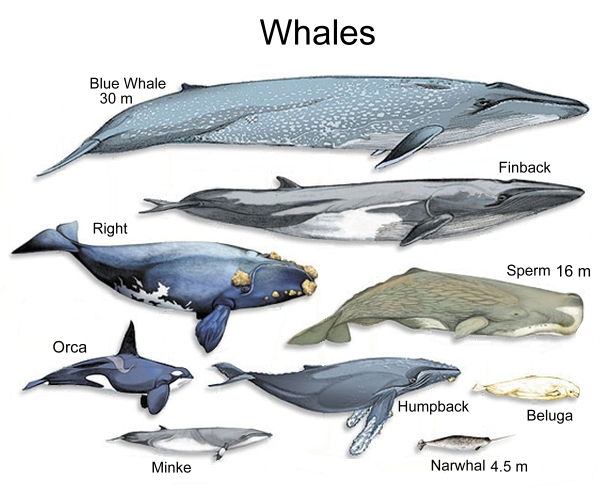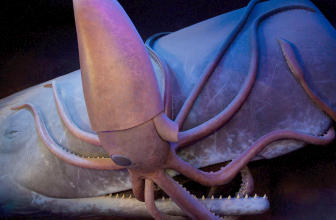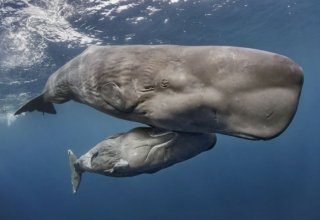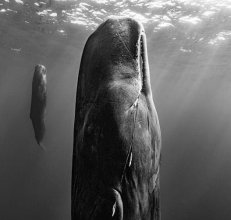 The Sperm whale, Physeter macrocephalus, is the largest predator on the planet, and is found throughout the world's oceans, including in and near the ice in the Arctic and Antarctic. The largest males can be found near the polar pack ice regions, in search of giant squid; squid that are in some cases larger in length than the whales themselves. Most will return to the tropical zones to breed a few months out of the year. The Sperm whale, a mammal, is one of the world's loudest and most recognizable animals, and is well known because this whale was the inspiration for Herman Melville's Moby Dick. Sperm whales are the largest of the toothed whales and have the heaviest and largest brain of any animal, weighing up to 9.5 kilograms. The whales themselves can weigh up to 55,000 kg. 
Whale oil was a popular commodity for use in candles, soaps, lubricants, cosmetics and oil lamps, and this made Sperm whales a target in the commercial whaling industry from 1800 to the 1980s. Destructive hunting practices almost wiped out all sperm whale populations. Some estimates suggest that the total Sperm whale population was reduced by 75% due to whale hunting. Thankfully, since the 1980s, whaling has become less of a threat, but the whale populations are still recovering. Sperm whales are still listed as depleted under the Marine Mammal Protection Act and endangered under the Endangered Species Act. Sperm whales are in fact one the world’s loudest animals, and they use their booming, loud sound as echolocation to hunt. Sperm whales dive in the dark, deep ocean, and relying on sound to locate their prey is important to their hunting. Some believe these creatures can even kill their prey with their sound alone. Sperm whales can eat up to a tonne (1000 kg) of food in one day, roughly 3% of their total body weight. Some estimates believe Sperm whales alone eat more than 91 million tonnes of the world’s squid population annually. Sperm whales dive for food at depths of 600 metres for up to 45 minutes, and then come back to the water’s surface between dives to recover and breathe. When hunting, a Sperm whale can swim at speeds of up to 30 km/h.  As mentioned, the Sperm whale is the world's largest predator. (The three larger animals, the Right, Finback and Blue whales, are filter feeders, eating shrimp-like organisms by straining ocean water through their baleen plates).
As mentioned, the Sperm whale is the world's largest predator. (The three larger animals, the Right, Finback and Blue whales, are filter feeders, eating shrimp-like organisms by straining ocean water through their baleen plates).A sperm whale's diet consists of: Sperm whales can live between 60 and 70 years. Most sperm whale females form bonds with other females in their families and create matriarchal groups of up to 12 females and their young. They stay with the same group in tropical waters for most of their lives. Males however leave their group before their early 20s and find other males to create new social groups. As they get older, they migrate toward the poles and some sexually mature males return to tropical breeding grounds to mate. Because sperm whales spend so much of their time hunting prey at deep sea levels, spotting a sperm whale near the coast is highly unlikely, instead sightings increase over deep water.   The birth of a baby Sperm whale is a rare and social event. With a gestation period of 14-16 months, sexually mature female sperm whales will only give birth once every 4 – 7 years. A group of sperm whales in the mother’s company will gather around her as she goes through labour. Once the calf is born, it gets 'passed around' to the other adult females while it learns to swim, all while getting jostled and nudged. After some time the calf is left alone with its mother to suckle and bond, while the other whales keep a protective barrier around the pair. The birth of a baby Sperm whale is a rare and social event. With a gestation period of 14-16 months, sexually mature female sperm whales will only give birth once every 4 – 7 years. A group of sperm whales in the mother’s company will gather around her as she goes through labour. Once the calf is born, it gets 'passed around' to the other adult females while it learns to swim, all while getting jostled and nudged. After some time the calf is left alone with its mother to suckle and bond, while the other whales keep a protective barrier around the pair.
|
